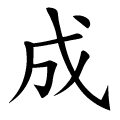成
- to accomplish;
- to succeed;
- to become;
Etymology
Phono-semantic compound combining:
戊 (무) – the 5th of the Ten Heavenly stems (天干 tiāngān), providing meaning;
丁 (정) – the 4th of the Ten Heavenly Stems, providing sound.
Words that derived from 成
- 구성(構成)–formation; composition
- 달성(達成)–achievement; attainment; accomplishment
- 대성(大成)–huge success; big hit
- 미완성(未完成)–incompletion
- 생성(生成)–creation; formation
- 성공(成功)–success
- 성공시키다(成功시키다)–succeed
- 성공하다(成功하다)–succeed
- 성과(成果)–result; outcome; product
- 성년(成年)–adult age
- 성립(成立)–validation; establishment
- 성사(成事)–accomplishment; achievement
- 성숙(成熟)–maturity; ripeness; growth
- 성인(成人)–adult; grown-up
- 성장(成長)–growth; development
- 성장기(成長期)–growth period; time for full growth
- 성장기간(成長期間)–growing period
- 성적(成績)–record; results; grade
- 성취(成就)–achievement; accomplishment; fulfillment
- 성형(成形)–shaping; plastic surgery
- 성형 수술(成形手術)–plastic surgery
- 성형외과(成形外科)–plastic surgery; department of plastic surgery
- 속성(速成)–being intensive
- 양성(養成)–training; education; fostering; building up; culture; cultivation
- 완성(完成)–completion
- 완성기(完成期)–completion stage
- 장성기(長成期)–growth stage
- 조성(造成)–building; development; fostering; promotion; instigation
- 합성(合成)–synthesis; compound; compounding; compound formation
- 합성어(合成語)–compound word
- 합성하다(合成하다)–compound; synthesize
- 형성(形成)–formation; building; development
- 형성하다(形成하다)–form; build; develop
Additional notes
In Chinese, it also has the numeric usage of “tenths”, e.g.
三成 = 30%
六成四 = 64%.
Alternative forms
Its composition of 戊 and 丁 traditionally makes it 7 strokes, but the simplified 6-stroke form is widely used today and accepted in modern script standards.
Full (standard) form:
戊 (5 strokes) + 丁 (2 strokes) = 7 strokes total.
Simplified writing form:
Many modern fonts write 丁 in a single ㄱ-shaped stroke, reducing 成 to 6 strokes.
Explanation from the Korean Language Society (한국어문회):
“The original character 成 has 7 strokes.
When 丁 is written as a single ㄱ-shaped stroke, it counts as 6 strokes.
The 6-stroke version is the simplified form (속자).”
Modern new-style scripts officially recognize the simplified (6-stroke) form.
- 戈竹尸 (IHS)
- ⿵ 戊 𠃌
- ⿵ 戊 丁 (U +2F8B2)
